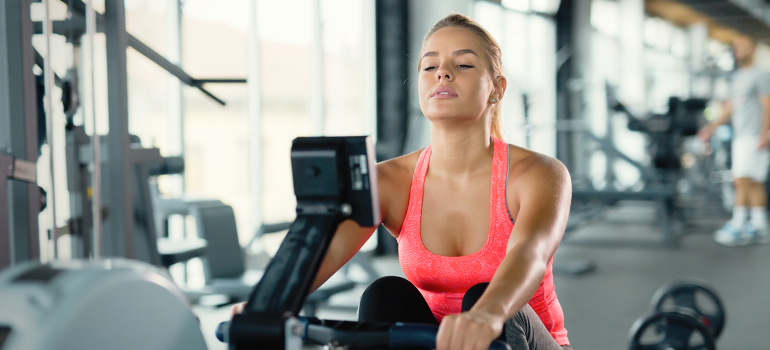Whether you’ve just started working out or you’re a dedicated, workout fiend, you may be wondering what you should do if (or more likely when) you get sick.
You very well may be able to relate to some of these scenarios…
You’ve gotten your workout routine down, you’re seeing progress, you’ve been super consistent, and you’ve been feeling great! Your workouts are now your “me time,” set aside to focus on you and your health. You’re crushing your fitness goals. Exercise has become part of your lifestyle, it has become part of your identity!
Then… dun, dun, dunnnnn… you get sick! You’re unsure if you should stay home, forego your workout, or press on. The questions start to roll through your mind…
Should I just keep working out?
Should I cease all activity?
Should I stay in bed all day?
What about my goals?
When can I start working out again?
I hear you! So, should you workout when sick? Let’s shed some light on when working out while sick is beneficial, when it’s alright, when it’s not alright, and when you can return to exercise. As a preface, this information is to be used as a guide, and not to be used in place of your doctor’s recommendations.
When Working Out Is Beneficial
We know exercising is an important component of overall health. But did you know that physical activity also helps prevent illness and boosts our immune system? It’s true! Working out regularly can help stave off sickness.
Research has shown that moderate aerobic exercise can decrease the risk of respiratory infections by half! You can cash in on this opportunity by simply following the Office of Disease Prevention and Health Promotion’s Physical Activity Guidelines. You’ll be doing your body good by taking preemptive measures to help you stay disease-free!
If you need exercise guidance to help you get ahead of the illness curve, check out the 7-day free trial to the LadyBossⓇ Pocket Personal Trainer. The trainer features awesome at-home workouts, weekly rotating gym workout schedules, and much more. As if we need more incentive to exercise, right?!
When Working Out Is Fine
You may be teetering on the fence about whether or not you should be hopping on the treadmill, pumping some iron at the gym, popping into a circuit training class, or doing a home workout routine. Let’s share some info about when working out is likely okay to get your swell on.
If you have a common cold without a fever, it’s typically alright to participate in moderate physical activity. Consider the following general guidelines for working out while sick:
- The “Neck Rule” – if symptoms are presented above the neck (runny nose, congestion, minor sore throat, sneezing), it’s typically alright to exercise.
- Be mindful of the intensity and duration of your workouts. It’s OK to dial it back when you’re feeling under the weather.
- Listen to your body, if you begin to feel symptoms are worsening with activity, it’s probably best to take a rest day.
- To keep from spreading potential germs, walking outside or working out at home are good options. If you decide to workout at the gym, be sure to wipe down equipment after use.
Speaking as a former athlete in a male-dominated sport, there was no dialing it back because you had the sniffles. There was no sitting out or taking a day off unless you broke your leg or something catastrophic happened. Conditioning every day after practice was non-negotiable. Needless to say, there were times in my life I felt as though I didn’t have a choice – or the decision to workout had been made up for me. It was going to happen whether I had a sore throat, or not.
While I do think there is a happy medium, being pushed to continue to work out when having a cold didn’t kill me. I am living proof, you can exercise if you have a runny nose! I do believe it’s important to listen to your body. And over the years, I have learned that it’s totally OK to dial it back when you’re sick!

When Working Out Is Bad
There are a few red flags that tell you not to exercise while sick. It’s probably best to take a rest from working out if you are experiencing:
- Symptoms below the neck (think stomach ache or chest congestion)
- Fever
- Flu
- Diarrhea
- Vomiting
- Body aches
- Fatigue
It is not advised to work out while having a fever or flu since it puts physical stress on the body. When your body is working to fight infection, adding more stress can force the immune system to work even harder. This can delay your recovery time from the illness. In these cases, it’s best to rest!
I had a recent experience that relates to this. My husband was away for work and I was holding down the fort with my 2-year-old and 8-month-old.
I was hanging out with the kids when it hit me like a ton of bricks. I had nausea, fatigue, muscle aches, and a cold sweat.
I sat at the dinner table just praying I could get both my kiddos fed and to bed so I could take care of myself. And when I say take care of myself, I mean hanging out in the bathroom with my head in a toilet all night long.
At that moment, working out was not something on my top priority list. Two days later, however, I was feeling better. And against my better judgment, I decided to hit it full force with a high-intensity circuit workout. GIRLS GOT GOALS, right!? Full-circle, I ended up back where I was a couple of nights prior. Nausea during workout = not fun!
My body was already working overtime trying to recover, and here I was trying to push it beyond the limits. And it ended up keeping me from getting back to full-throttle sooner.
Rest is so important to recovery, as is taking a slower, progressive approach to getting back to slaying it at the gym.
Returning to Exercise
If you’ve had to take time off from your workout, it’s best to reintegrate your workout regimen progressively. Going for a walk or doing some light stretching is a good way to get your body moving again.
When on the rebound, getting some fresh air and moving your body just feels good, doesn’t it!? When my Personal Results Coaching clients ask about doing cardio when sick or recovering from being sick, I typically recommend taking a nice, easy walk. They come back from the walk revitalized. Let’s face it, nobody wants to be bound to the couch, bed, or bathroom for a long period of time. When you feel well enough to walk around the house, lace up your sneakers and venture outside for some fresh air.
If you had above the neck symptoms, within a few days, you should be good to begin increasing the intensity of your workouts. Remember to take it easy as your body has been working hard to get you back to your present state.
If you had below the neck symptoms, it’s best to wait until after your symptoms have resolved before beginning moderate-intensity activities. Learn from my experience with this one! Make sure any muscle aches or weakness have subsided before trying vigorous exercise. After a couple of weeks, you should be able to incorporate higher intensity activities.
Believe me! I get it, when we have specific goals, it’s hard to stay away from the gym and/or our workouts. We want to rush back in and get right back to it. I like to remind my clients that it’s important to be mindful of your body and the time it may take to get back to where you were post-illness.
Recognize Your Limits
We are all susceptible to cold and flu season. If you have children who are in school or work in close quarters with others, all seasons are fair game. Incorporating and maintaining a workout routine can help keep you healthy year-round. Generally speaking, if you happen to catch a cold above the neck, it should be OK to continue exercising. However, if you experience symptoms below the neck, have a fever, or have the flu, it’s probably best to give your body some rest. Don’t rush back into vigorous activities. Remember to take a progressive approach in easing back into your workout plan.
























